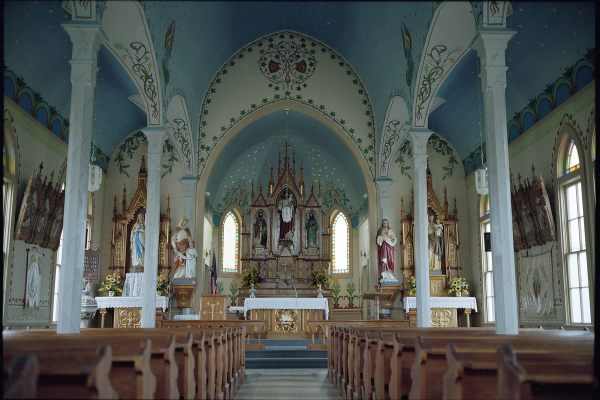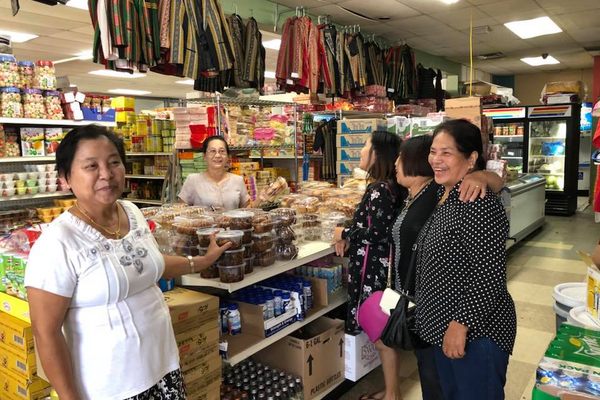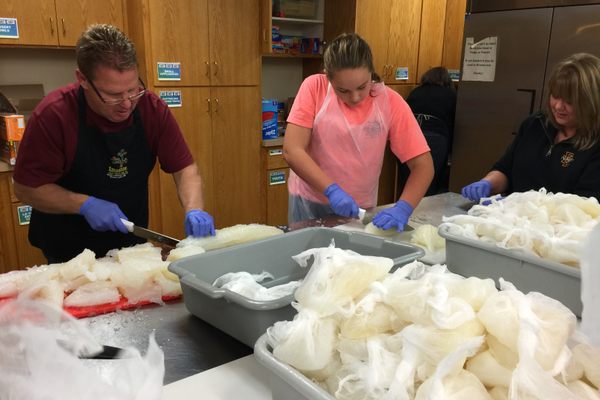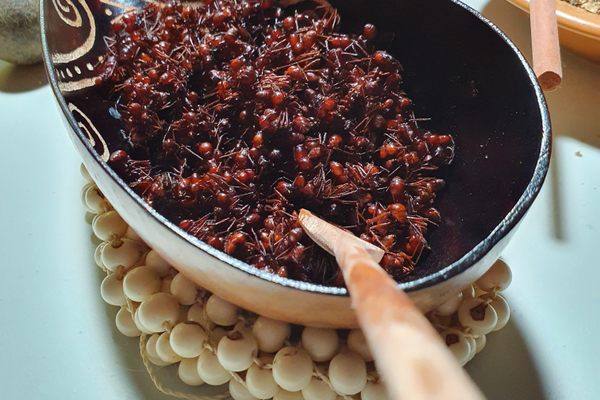Inside a Brazilian Chapel Made Out of Wine
During a drought, church-builders mixed their mortar with the local vintage.

Within the state of Rio Grande do Sul, at the southernmost tip of Brazil, is the Vale dos Vinhedos: the Valley of Vineyards. With its landscape of rolling green hillsides dotted with family farms, the vista could easily be mistaken for Tuscany. The state produces 90 percent of the nation’s wine, with more than 30 wineries in the Vale dos Vinhedos alone. At the heart of this community stands a chapel called the Capela Nossa Senhora das Neves, or the chapel of Our Lady of the Snow. Though small and unassuming, this building is distinguished in a particularly appropriate way: It was constructed out of wine.
The church’s viniferous origin is detailed in its decor. The tiny chapel features an altar made with wine barrels, and the exterior is outlined with wine-red paint. But the very mortar holding the bricks of the church’s walls together is made of wine: a testament to the creativity of the local Italian immigrants when faced with a debilitating drought. Wine created a solid foundation for their building, and for their new home in the Vale dos Vinhedos.
Long before the construction of the wine chapel a century ago, the land was originally occupied by the Tupí-Guaraní and other indigenous peoples. Jesuit missionaries from Europe arrived in the 17th century, intent on evangelizing and moving them into missions. In the 19th century, Italian immigrants settled in the valley, the majority from the northern regions of Veneto and Trentino. These immigrants were mostly peasants, drawn to southern Brazil by the promise of their own farms. The imperial government of Brazil played a part in luring many to the area. According to Walter Comassetto, a descendant of Italian immigrants who arrived in Rio Grande do Sul in 1878, “the government made the decision to occupy the lands with no legal ownership.”

At the time, there was still slavery in Brazil, which would last until 1888. But the government knew that the abolishment of slavery was certain. To resolve the looming lack of labor, their racially charged solution was “to invite, or to bring, or to hire,” Europeans. “White Europeans, preferably,” Comassetto says. Immigrants from Italy, Portugal, and Spain were especially ideal, because they were Catholic. With that decision, the imperial government set out to have such settlers cultivating land across the country.
The government created agencies authorized to invite people to settle in Brazil. Starting in Germany, they soon moved on to other European countries. With flyers, the agents immediately began spreading lies, boasting that new immigrants could own castles in Brazil, and that there was plenty of land for everyone. (What they didn’t mention was that most of the land on offer was unoccupied because it was all forest.)
But the agents persisted, vowing to potential immigrants that Europe’s future was in Brazil. Often, the promised land was referred to as America. “Andiamo a fare America, let’s go to America, let’s be successful. This is what they said,” Comassetto says. The agents came to his great-grandfather’s church in Italy. With little local land left to farm, his family decided to take a chance and move.

As Italians landed at the port city of Porto Alegre, they were given parcels of land to settle in the unruly region of Serra Gaúcha, an area with steep hills and rocky terrain in Rio Grande do Sul. Life in the future Vale dos Vinhedos was soon dire. Disease ran rampant, and instead of their promised castles, families lived off the land in the harshest of conditions, often with nothing to eat. But many survived, and after a four-year wait the immigrants were granted the papers of their designated land.
Wanting to recreate the comforts of their homeland, the settlers raised livestock to provide themselves with meat and cheese, and grew fruits and vegetables. Importantly, they began planting grape vines, from seedlings brought by the Germans. Soon, they threw themselves into making wine just as they did in Italy. In the fertile soil and hot sun of Serra Gaúcha, their vineyards thrived.
Religion was always an important aspect of their lives. As Italian immigrants across Brazil established themselves in their new country, many soon turned to the construction of a local church or chapel. “The church became the point of entry, the point for them to get together,” Comassetto says. “People congregated there for everything—for business, for worship, to play, to have some fun during the weekend.”

In the new Serra Gaúcha town of Bento Gonçalves, the construction of Nossa Senhora das Neves was spearheaded by Marco Valduga, a member of one of the first Italian families in the Vale dos Vinhedos region. His inspiration came from back in Italy. According to legend, on one cold morning in his home country, Valduga saw that some snow had fallen into the image of the Virgin Mary, or Our Lady of the Snow.
The vision inspired him. “His neighbor, who was a sculptor, took a piece of wood and carved the image,” says Assunta de Paris, a Bento Gonçalves historian. Before Valduga set out for Brazil, “the neighbor handed the image of the saint to Marco and asked that he build a church in honor of Nossa Senhora das Neves.” How could he refuse? In 1904, soon after moving to the area, the Valdugas and 20 other families began construction. They cut stones and made mortar out of clay and water.
But then, disaster struck. A period of intense drought overtook the land for two years and there was not enough water to continue the work. The drought was punishing, wilting crops as it spread throughout the region. According to de Paris, the local families decided to appeal to Nossa Senhora das Neves for a way forward. “Red stains on the stones of the church were noticed during the prayer,” says de Paris, reminiscent of wine stains. “It was then that the priest told everyone in the church to stop praying, that he had the solution.” They would use their wine, instead of water, to make the mortar for the unfinished church.

The construction began a second time. Each local family donated 300 liters of their own wine supply. After kneading clay with the wine and adding wheat straw for stability, there was enough mortar to cement their bricks together. Everyone in the community had a hand in the construction, and the chapel was completed in 1907.
After more than 100 years of wear and tear, the chapel is now being professionally restored. According to Rui Stefani, a building restorer from the area, “the wheat or straw mixed with wine was never dry enough or cooked enough, because they were not technicians.” Some of the interior walls have large cracks, and brickwork peeks through the plaster. Stefani is patching up these cracks and working on other restoration plans.

The story of Capela Nossa Senhora das Neves has been passed down to each generation, and Stefani, along with other local painters, is adding a mural depicting the chapel’s history on one of the interior walls. But the chapel no longer hosts services. According to Daniele Pistoia Araujo, the executive secretary of the Bento Convention Bureau, “the church is only used as a tourist and visitation place.” (She also notes that in the last year, the town of Bento Gonçalves received more than 150,000 visitors, many drawn by the town’s status as a node of Brazilian wine.)
The chapel still is thought of fondly by locals, not just as a symbol of their faith, but as a reflection of the ideals at the time it was built and the labor of the people who settled there. To many, says de Paris, the church mirrors the determination to build community with hard work and faith—not to mention wine.
Gastro Obscura covers the world’s most wondrous food and drink.
Sign up for our email, delivered twice a week.


































Follow us on Twitter to get the latest on the world's hidden wonders.
Like us on Facebook to get the latest on the world's hidden wonders.
Follow us on Twitter Like us on Facebook